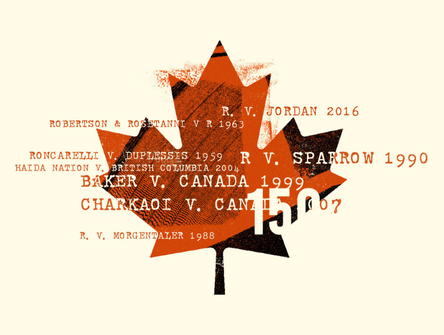A new beginning
A law on implementing UNDRIP marks a welcome breakthrough in advancing reconciliation. But there is work ahead to hold government accountable.
.jpg?ext=.jpg)
When the Canadian government first endorsed the United Nations Declaration on the Rights of Indigenous Peoples in 2010, it did so with an asterisk, specifying that it was "aspirational" and non-binding legally. It took six years before Crown-Indigenous Relations Minister Carolyn Bennett declared Canada a "full supporter of the Declaration without qualification." Then came a first attempt to enshrine UNDRIP into Canadian law, but Romeo Saganash's private member's bill C-262 died on the order paper after the Senate failed to bring it to a final vote in 2019. Bill C-15, tabled in December 2020, repackaged the substance of C-262, with a much longer preamble and an explicit repudiation of the doctrines of discovery and terra nullius that European settlers had relied on for decades to assert their sovereignty. Fittingly, C-15 received Royal Assent on National Indigenous Peoples Day, and UNDRIP is now affirmed as a source for interpreting Canadian law.
For a new generation of lawyers, it means they have an incredible advocacy tool at their disposal, said Merle Alexander, a principal at Miller Titerle Law Corporation, during a recent CBA symposium held just before C-15 became law on June 21. "It's probably going to be the work of the next seven generations of advocates," he said, acknowledging that the cut and thrust of debate will focus on the distinction between consent and consultation regimes involved in the development of natural resource projects. "It could be a dramatic change in the law; it's material to all the work that we do."
Indeed, the potential reward is enormous for Indigenous communities in Canada. Apart from containing broad and aspirational language, C-15 states the need for "free, prior and informed consent" (FPIC) from Indigenous Peoples on legislative measures and projects that infringe on their lands or rights, or that may affect them. FPIC is a concept that, while still ill-defined, is likely to influence not only the Crown's approach to consultation but the practical expectations of other parties involved, namely industry and Indigenous communities.
The law offers the country a new opportunity, according to Alexander, to move on from the uncertainty that is holding back Canada "as a nation."
The other big question is how the pace of change will fare compared to expectations. "One of my hopes is that people can be patient," said Brenda Gunn, a law professor at Robson Hall, during the symposium. "This is the starting point, not the finishing point." Gunn is wary that there will disappointment not unlike that expressed by supporters of Indigenous rights following the adoption of the Declaration on the Rights of Indigenous Peoples Act (DRIPA) in British Columbia two years ago. The province, critics say, has failed so far to take meaningful steps to ensure that its laws are consistent with UNDRIP. It also has yet to produce an action plan to achieve the objectives of the Declaration.
Getting C-15 to royal assent was hard enough. Getting the federal government to produce an action plan will be harder still. Prime Minister Justin Trudeau is likely headed toward calling a federal election. Meanwhile, a government not always known for its ability to follow through has ambitious plans to shift to a net-zero economy while managing a post-pandemic economic recovery.
In the end, succeeding at UNDRIP will depend as much on good government as getting all parts of the state to recognize Indigenous peoples as decision-makers.
"[T]he federal government needs to take a lead role in the practice of FPIC," according to the CEO of the First Nations Financial Management Board, Geordie Hungerford, also a panelist at the symposium. "We can't be leaving it to private industry and First Nations in the courts. The feds and the provinces need to facilitate the process of FPIC. And the federal government, through that, must communicate the rights and responsibilities of UNDRIP to the private sector and other levels of government."
Gunn also acknowledged that advocates for change will have to push the government to move quickly while "recognizing that truly implementing the UN Declaration requires a huge change in government thinking because they're not going to be the sole decision-makers in many areas."
Alexander, for his part, wants to see a dedicated secretariat created — something that has been promised in B.C. — to ensure new legislation and policies are consistently harmonized with UNDRIP.
Beyond that, four other things must happen, Hungerford adds. First, there have to be metrics and targets to guide all federal departments and agencies in making FPIC a reality – all part of a performance management program for senior officials in the government. Under the law, the government must report annually, in consultation and cooperation with Indigenous peoples, on the measures taken to ensure that the laws of Canada are consistent with UNDRIP and the preparation and implementation of the action plan to achieve the objectives of the Declaration. "There needs to be action, and there needs to be accountability," said Hungerford. "And through that, I think there needs to be representation of Indigenous people in all ranks of the civil service. By having more Indigenous people, particularly in the senior leadership, there'll be more of a recognition of what needs to happen."
Second, Indigenous communities need more professionals in business to activate economic opportunity. "Reconciliation is going to require innumerable Indigenous business leaders who can lead in government, […] the private sector and play that role of communicating between the private sector and Indigenous groups," said Hungerford. Leadership is also necessary within the communities themselves, he added, "to lead, start businesses and drive economic development."
The challenge is that only 10.9% of Indigenous peoples aged 25-64 have a university degree, compared to 29.3% of the non-Indigenous population, he said. It will be necessary to do more outreach at high schools to recruit future business leaders, offer Indigenous scholarships and internships, and come up with alternative paths for professional designations to be more accessible for members of the communities.
Third, economic development requires access to capital, said Hungerford, "on a very large scale at reasonable rates, if we want to see First Nations participating as they should with equity stakes in businesses and in economic opportunities on their own traditional territories." But in a country with over 630 First Nations, it will be challenging to assess opportunities as they come up, Hungerford added. There has to be some ability to build capacity and potentially look at the aggregation of Indian Act bands and First Nations so that there is an ability to build scale, and be able to take advantage of the opportunity."
But ultimately, Hungerford concluded, Canada's governments and Indigenous peoples need to strike a new fiscal deal. "We need longer term funding for First Nations, and we also need an ability to use the government's balance sheet for guarantees to fund equity participation." He said that Canada should consider setting up an Indigenous infrastructure bank.
All of which is to say that there is much work to be done. In the meantime, it will be up to lawyers to remind the courts that UNDRIP is now part of Canada's international human rights obligations, said Gunn, who is calling on lawyers to brush up on their understanding of international law. "If you didn't take international law in law school, if you don't know the basics of human rights law and international human rights law and how that applies to Canada, you are not competent to provide a legal opinion to a client," she said. It's essential they learn how UNDRIP works with other international human rights treaties, she added. "Because free, prior, informed consent didn't come out in the UN Declaration. It's been recognized since the 1990s in the United Nations Human Rights treaty bodies […] You can't just read the UN Declaration. There are studies; there are reports; there's decades of work that help inform us and understand what the UN Declaration means in Canada."
Finally, there will be a more fundamental question Indigenous governments will need to consider, added Gunn: What does it mean to participate in decision-making? According to Gunn, implementing UNDRIP may be a powerful tool for Indigenous people in moving beyond the legacy of colonialism, but it involves more than saying yes or no to proposed projects. “Indigenous peoples need to be at those tables having real influence and ability to participate in the decision-making,” she said. “It's about being part of the decision to make sure we're protecting our fundamental human rights.”


